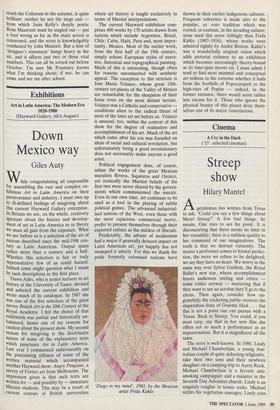Exhibitions
Art in Latin America: The Modern Era 1820-1980 (Hayward Gallery, till 6 August)
Down Mexico way
Giles Auty
While congratulating all responsible for assembling the vast and complex ex- hibition Art in Latin America on their Perseverance and industry, I must own up to ill-defined feelings of misgiving about this current Hayward Gallery enterprise. In Britain we are, on the whole, relatively Ignorant about the history and develop- ment of art in Latin America so in theory we must all gain from the exposure. What we see before us is a selection of the art of nations described since the mid-19th cen- tury as Latin American. Output spans rather more than a century and a half. Whether this selection is fair or truly representative few of us could hazard. Indeed some might question what I mean by such descriptions in the first place. Dawn Ades, who is senior lecturer in art history at the University of Essex, devised and selected the current exhibition and wrote much of its catalogue. In 1987 she was one of the five selectors of the giant survey British Art in the 20th Century at the Royal Academy. I felt the choice of that exhibition. was partial and historically un- balanced, hence one of my reasons for caution about the present show. My second reason for misgiving is the doctrinaire nature of some of the explanatory texts which punctuate Art in Latin America. Last year I commented unfavourably on the patronising silliness of some of the written material which accompanied another Hayward show: Angry Penguins, a survey of Forties art from Melbourne. The impression given is that such texts are written for — and possibly by — immature Marxist students. This may be a result of current courses at British universities where art history is taught exclusively in terms of Marxist interpretations.
The current Hayward exhibition com- prises 400 works by 170 artists drawn from nations which include Argentina, Brazil, Chile, Cuba, Haiti, Peru and, most impor- tantly, Mexico. Most of the earlier work, from the first half of the 19th century, simply echoes European styles of narra- tive, historical and topographical painting. Much of this is interesting, though often for reasons unconnected with aesthetic appeal. The exception to this stricture is Jose Maria Velasco, whose great 19th- century set-pieces of the Valley of Mexico are remarkable for the sharpness of their focus even on the most distant terrain. Velasco was a Catholic and conservative conditions alien to the radical thrust of most of the later art set before us. Velasco is unusual, too, within the context of this show for the degree of realisation and accomplishment of his art. Much of the art which came after his era was founded on ideas of social and cultural revolution, but unfortunately being a good revolutionary does not necessarily make anyone a good artist.
Political engagement does, of course, infuse the works of the great Mexican muralists Rivera, Siqueiros and Orozco, yet ironically the Marxist beliefs of the first two were never shared by the govern- ments which commissioned the murals. Even in our own time, art continues to be used as a tool in the playing of subtle political games. The advanced industrial- ised nations of the West, even those with the most rapacious commercial mores, prefer to present themselves through their exported culture as the mildest of liberals.
Predictably, the advent of modernism had a major if generally delayed impact on Latin American art, yet happily has not swamped it utterly. For this we thank the pride formerly colonised nations have 'Diego in my mind', 1943, by the Mexican artist Frida Kahlo shown in their earlier indigenous cultures. Frequent reference is made also to the popular, ex voto tradition which was rooted, in contrast, in the invading culture; none used this more tellingly than Frida Kahlo (1907-1954), whose works were admired rightly by Andre Breton. Kahlo's was a wonderfully original vision which adds pictorial richness to an exhibition which becomes increasingly theory-bound as its time-span moves on. I must admit I tend to find most minimal and conceptual art tedious in the extreme whether it hails from the foothills of Popocatapetl or the high-rises of Poplar — indeed, in the former instance, there would seem rather less excuse for it. Those who ignore the physical beauty of this planet deny them- selves one of its major consolations.


















































 Previous page
Previous page